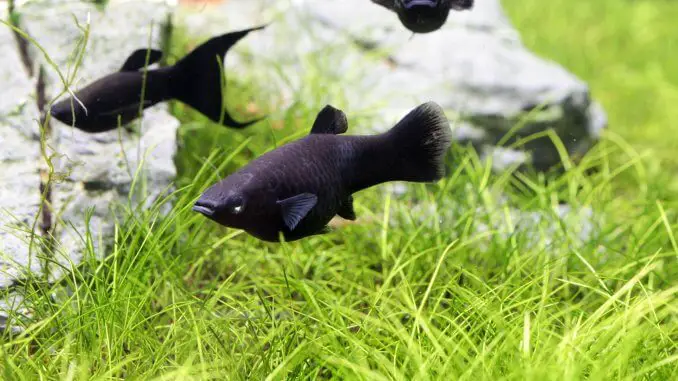
The molly fish is a freshwater fish of the Poeciliidae family. There are several types of molly fish, including black molly fish, sailfin molly fish, Dalmatian molly fish, balloon molly fish, and lyretail molly fish.
Mollies come in a range of colors, including black, white, silver, red, and orange.
Due to their ability to adapt to almost any environment, molly fish are popular amongst beginner aquarists. Mollies are peaceful and get on well with other species, making the fish a good addition to a community tank.
TABLE OF CONTENTS
Molly Fish Facts & Overview
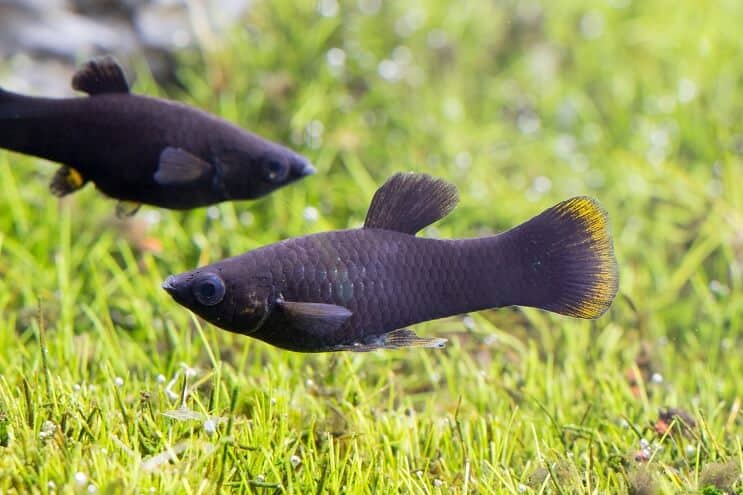
| Scientific name: | Poecilia sphenops |
| Common names | Molly fish, molly, common molly, short-finned molly |
| Distribution: | Central America and southern United States |
| Size: | 3.5–4.5 inches |
| Life expectancy: | 3–5 years |
| Color: | Black, silver, white, red, gold, orange, purple, blue |
| Diet: | Omnivore |
| Temperament: | Peaceful |
| Minimum tank size: | 10 gallons |
| Temperature: | 72–78°F (22–25.5°C) |
| pH: | 7.5–8.5 |
| Hardness: | 15–30 dGH |
| Care level: | Easy |
| Breeding: | Livebearer |
Origin
Molly fish are found in parts of Central America, like Mexico, and the southern United States.
Mollies thrive in freshwater environments, but the fish are also common in saline habitats, like lagoons and brackish ditches. Some mollies live and breed in shallow marine environments, like harbors and waters around the roots of mangroves.
Mollies are common in the wild. Colorful species of molly fish are bred in captivity, and wild molly fish are a dull, silvery-gray color.
Adult Size & Lifespan
Adult mollies reach up to 4.5 inches in length. Female molly fish grow bigger than male mollies — males grow to around 3.5 inches in length. Males are skinnier than females too, while females have rounder abdomens.
The life expectancy of a molly fish varies depending on the subspecies, but on average, male and female molly fish live for between three and five years in captivity.
Availability
Molly fish are affordable and widely available in pet stores and online. The cost of a single molly fish is $2 to $8, depending on the seller and the type of molly.
You should buy at least four mollies for an aquarium, bringing the total minimum cost to $8–$32. Some sellers offer freshwater starter packs that include mollies, which cost from $50 to $100, depending on the number of fish.
- LiveAquaria sells a range of mollies including Dalmatian mollies, silver mollies, balloon mollies, black mollies, and gold dust mollies.
- Imperial Tropicals is another good molly fish vendor, selling black mollies, marble mollies, sunset mollies, creamsicle Dalmatian mollies, and an assorted molly package.
Appearance & Behavior
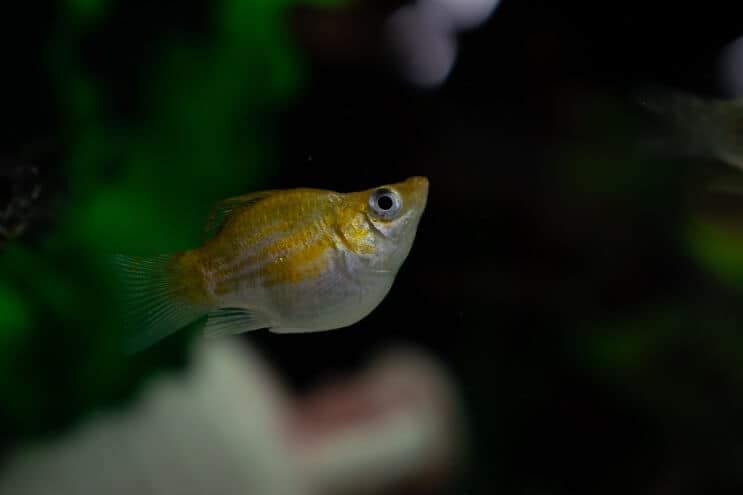
Molly fish come in a variety of colors, tail shapes, and patterns. Most mollies are between 3.5 and 4.5 inches in length, with flattened bodies and short fins.
When housed in a non-stressful tank environment with non-hostile tank mates, mollies are peaceful fish that rarely show aggression.
Colors, Patterns, Fins, and Sex Differences
Different types of mollies have different appearances:
- Black mollies (the most common molly fish type) have all-black bodies and rounded fins between three and six inches long.
- Sailfin mollies have light gray bodies with rows of dark gray spots and an enlarged dorsal fin that looks like a boat sail.
- Dalmatian mollies resemble the Dalmatian dog breed, with rounded fins and shiny, silver-white scales, decorated with black spots.
- Balloon mollies have short, rounded bodies, like an inflated balloon, in colors including white, silver, black, orange, and yellow.
- Lyretail mollies have a caudal fin that narrows into points at the top and the bottom, and trails behind the fish as they swim.
Different types of male and female mollies have their own unique differences. For instance, the anal fin on a male common molly is long and points backward, while the anal fin on a female common molly points down.
In most molly fish types, males have bolder and brighter colors than females. Mollies fade in color as a result of stress, and some molly fish get darker or change color or pattern as the fish age.
Typical Behavior
Mollies are a peaceful fish species that gets on well with other fish. However, there are some triggers that cause molly fish to become aggressive, including aggressive tank mates and a crowded tank.
As sociable schooling fish, mollies prefer to be housed in groups of four or more. Buy one male molly fish for every four female mollies in your tank to prevent the males from fighting and asserting dominance.
Mollies are used to living in shallow water, so the fish swim near the top of the tank. As timid fish, mollies prefer plenty of hiding places, like plants and caves, where they can retreat when they feel unsafe. Mollies are diurnal, meaning they are the most active during the day and sleep at night.
Molly Fish Care & Tank Requirements
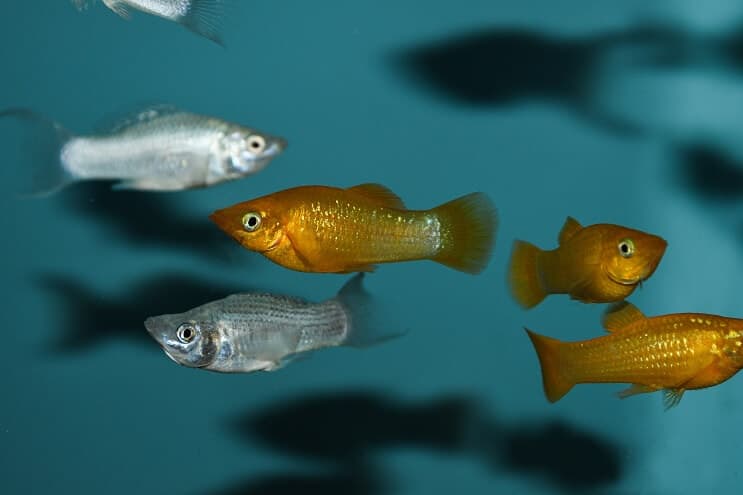
Creating the right tank environment for molly fish is easy because the fish are adaptable and hardy. In the wild, molly fish live in loosely vegetated, shallow surface waters. You should create a similar environment in a freshwater planted tank.
As omnivores, mollies get their protein from insects and insect larvae, small fish, and small crustaceans. The fish enjoy plant matter and algae too.
Habitat and Tank Requirements
Mollies are found in rivers, streams, lakes, swamps, deltas, estuaries, marshes, and shallow surface waters.
Because mollies are adaptable to a large range of environments, the fish can withstand wider temperature and pH ranges. However, you should still create an environment that replicates the molly’s natural environment to ensure the fish thrive in captivity.
Foliage in a molly’s tank is important, and the plants can be held in place with a thin layer of sandy substrate. Mollies don’t spend a lot of time at the bottom of the tank, so you shouldn’t worry that they’ll disturb loosely-rooted plants.
Tall plants like anubias nana and short varieties like Java fern provide shelter and a hiding place for molly fish. Rocks and caves give mollies a place to escape to if the fish are being hassled by their tank mates.
Mollies are used to brackish water in the wild, but recreating this in captivity is difficult, and limits which species of fish can be considered as tank mates for mollies.
Tank Conditions
The ideal tank conditions for molly fish are:
| Water type: | Hard, freshwater |
| Tank size: | Minimum 10 gallons for up to four mollies, followed by 3 gallons per extra molly fish |
| Water temperature: | 72–78°F |
| Substrate: | Sand, rocks, pebbles |
| Tank setup: | Plants, caves |
| Acidity: | 6.7–8.5 pH |
| Water hardness: | 15–30 dkH |
| Filter: | Yes, to remove excess ammonia, nitrate, and debris |
| Bubbler: | Yes, to oxygenate water |
| Lighting: | No, unless in planted aquariums that get little natural daylight |
| Water heater: | Yes, to replicate the tropical climates that mollies are used to |
| Pump: | No, mollies are used to slow-moving water, so don’t need a fast current |
Once you’ve established the right tank conditions for your molly fish, make sure these conditions are maintained. Use a thermometer to check the water temperature and a pH meter to check the pH.
Well-maintained water parameters will ensure your mollies thrive in captivity.
Disease
There are several common freshwater diseases that affect molly fish in captivity:
Ich
Ich, caused by the protozoan Ichthyophthirius multifiliis, affects the majority of freshwater fish. The disease is characterized by white spots, which look like salt sprinkles, on the fish’s fins, body, and tail. Fish with ich appear lethargic and rub against rough surfaces.
Treat ich by moving the affected fish to a quarantine tank, increasing water temperature by two degrees, and adding one tablespoon of salt per five gallons of water in the tank.
Velvet
Velvet is another common molly disease that is caused by a parasite called Oodinium. The parasite burrows into the fish’s skin and produces gold, rust-like cysts. Molly fish with velvet will dart from one end of the tank to the other, appear lethargic, and rub against rough surfaces.
Treat velvet by switching off the tank’s lights and adding copper sulfate, acriflavine or formalin to the tank as recommended by your veterinarian.
Fin and Tail Rot
Long-finned mollies and mollies with fan-like tails are at risk of developing fin rot and tail rot. This disease is caused by a bacterial infection resulting from overcrowding, poor-quality water, and stress. A molly fish with fin rot will have frayed, ragged, and milky-colored fins.
Carry out a full water change to treat fin and tail rot, and use antibiotics if you don’t see an improvement in the fish’s symptoms within one week.
Tank Mates
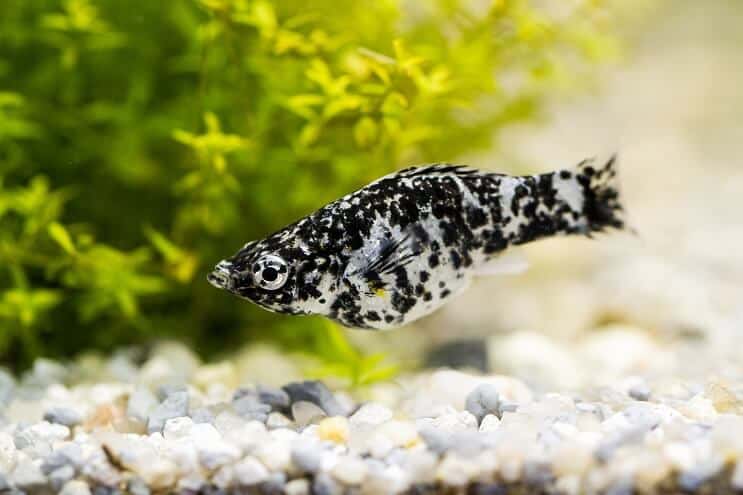
Mollies are peaceful, but the fish show signs of aggression when housed in overcrowded tanks or with aggressive tank mates. For this reason, you should house molly fish with friendly fish, and give the fish plenty of space to swim in.
Because mollies enjoy the company of other mollies, you should prioritize buying at least four mollies before you consider adding different fish to your aquarium.
Great tank mates for molly fish include:
- Guppies
- Danios
- Platys
- Gouramis
- Tetras
- Angelfish
- Swordtails
- Some cichlids (dwarf cichlids, keyhole cichlids, ram cichlids)
Molly fish can also be housed with non-fish tank mates including:
- Snails
- Algae-eating crabs
- Shrimp
Diet and Feeding
In the wild, molly fish eat small invertebrates and plant matter like algae. Feed mollies the same diet in the tank to ensure the fish get the essential nutrients from their meals.
Algae is a staple in the molly fish’s diet, and growing algae in your tank is the best way to provide your fish with this food source. Feed your molly fish algae wafers if your tank doesn’t contain enough algae to feed all your fish. Spinach, lettuce, and zucchini are good plant-based options for molly fish, too.
Fish flakes, and live or frozen foods like bloodworms and brine shrimp, should also be added to your molly fish’s diet to vary the nutrients the fish receives. Rotate between plant matter, fish flakes, and live foods to ensure your molly fish get all the nutrients they need.
Feed mollies a pinch of food twice a day. Don’t allow mollies to eat continuously for more than two minutes because too much food overloads the fish’s digestive system.
Breeding
Molly fish are easy to breed in captivity and are a good choice for people who are new to breeding fish. Mollies are livebearers, meaning that the females retain their eggs in their bodies before giving birth to live babies.
To breed molly fish, follow these steps:
- Choose a suitable male and female. Molly females prefer to mate with the largest males in the tank.
- Place the male and female in a breeding tank with clean water at a temperature of 78°F.
- When the male is ready to mate, he’ll perform a courting display for the female.
- If the female shows no interest in the male after two days, swap the male molly fish for another male.
- If the female consents to breeding, the male will fertilize the female by transferring milt into the female’s body using his anal fin, known as a gonopodium.
- Wait up to 45 days for the female to give birth. Female mollies can give birth to up to 100 juveniles.
- When the female is ready to give birth, she will hide in a dark, secluded area of the tank.
- When the baby fish have been born, remove the parents from the breeding tank and return them to their home tank. This prevents the parents from eating their young.
- Feed the fry powdered fish flakes until the fish are able to eat the same food as adult mollies, at around two months old.
Should You Get a Molly Fish for Your Aquarium?
If you already have a tank with peaceful fish and the right conditions for mollies, or you plan to establish a tank with these conditions, you should consider getting a molly fish for your aquarium.
If your tank is crowded or you have aggressive fish, reconsider whether molly fish are the right choice for you.
As long as molly fish are housed in the right water parameters with the right tank mates, the fish are a fun, colorful, low-hassle addition to a home aquarium.
Molly Fish FAQs
- Can you keep just two mollies?
- Do mollies clean the tank?
- How many mollies should be kept together?
- Do mollies need a heater?
- Why do molly fish stay at the top of the tank?
- How many babies do molly fish have?
- Where do molly fish come from?
- How much do molly fish cost?
- How big do molly fish get?
- How many mollies can I put in a 10-gallon tank?
- Do mollies eat their babies?
- How long are molly fish pregnant?
- What is the lifespan of molly fish?
- Are mollies fin nippers?
- Do mollies need an air pump?
- Can mollies live in tap water?
- Why is my molly fish aggressive?
- How do I keep my molly fish happy?
- Are molly fish easy to care for?


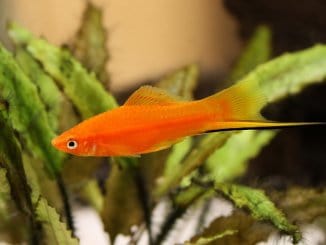
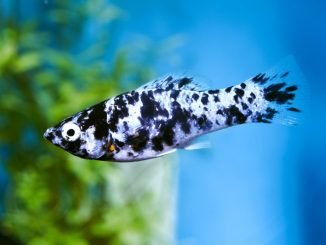

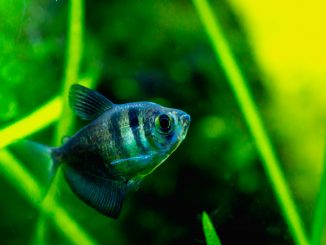
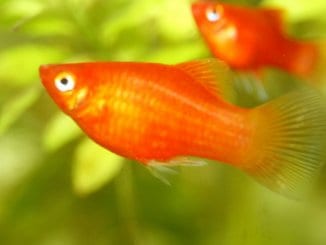
Just retired at 69 years old and enjoying my aquariums again. I’m interested in a list of plecos that will spawn in captivity and what tank conditions they need to be successful. I’ve had success with albino plecos and would like to try others. Thank you. I enjoy reading your articles as they come on the fishkeeping site. Molly fish are enjoyable and the article was a good basic topic for all fish keepers. Thank you again.
Hi Dale, thanks for your message. Congratulations on your retirement. Bristlenose Plecos are quite easy to breed in captivity. We have an article on how to do that here: https://www.fishkeepingworld.com/bristlenose-pleco/#Bristlenose_Pleco_Breeding. We will be writing more articles on Pleco’s in the coming months so keep an eye out. Thanks, Robert
I just got m 6 year old daughter a small, 1gal, corner tank with an xs filter. She already has a beta (in a separate tank) so she wanted something different. We ended up getting 2 mollies and a small panda cory for her small tank. But we weren’t informed that they required a heater. We’ve only had them for 24 hours, but now I’m concerned. Is there something I should be doing? Should I be rushing out to get a new tank? Or do I need a heater? Do they even make heaters for a 1 gal tank? I didn’t think that Mollies would be difficult to keep. I’m just not sure what to do.
Yikes. Betta fish need at least 5-10gal to live happy. Its a huge myth that they like tiny tanks. As stated above, a single molly requires at LEAST 10gal. If you have other fish in with them, i cant see them living very long in such a small, crammed tank. I would consider getting a nice 20gal for the community fish, and a 10 gal for the betta since it cannot live with other fish.
@Heather Johnson
2 mollies and a panda cory in a gallon tank? That is way, way, way too small of a tank. I can’t really stress enough how too small of a tank that is… hopefully by now you’ve gotten them a larger tank. If not, they’re probably dead or close to it.
That tank is way to small for molly fish in my opinion mollys should always be kept in a 20 gallon tank or larger. Also panda corys need to be kept in schools of three. also these are tropical fish so they definitely would need a heater.
Definitely need a bigger tank…
I really hope you went to the store and got a tank that’s a least 10 gallons and a heater and a lamp
I know it’s knida late for the response…but no you do not need a heater. I have a 3.5 gallon tank and the reproduce just like my 60 gallon tank with a heater.
Man…. that is way way way too small for that many fish. Betas need a heater too. Molliesime to live in groups if 4 or more. You need at LEAST a 10 gallon tank gor all if those fish.
Betas alone cant even live in a 1 fallon tank. They need 2.5 MINIMUM
U need a bigger tank with a heater and a filter
I just got my fish today and only have one but want to get more but the people at the store didnt tell me the gender so i dont know what gender fish to get? How do I tell?
If it is a balloon molly or any mollie a boy looks like a hook on the bottom fin and a girls bottom fin is round
The males anal fin will be pointed and the females will look like a normal fin. hope this helps!
For a female, the anal fin is shape of a fan and the male is like a pointed stick. Usually the ratio is 4 females to one male so that the female will not be stressed out due to the male wanting to mate ALL the time.
Hey Kelly!
I know this is quite a late reply, the female mollies have two fan-looking fins on the bottom. The males have a long-looking fin at the bottom that sticks out. It’s a little harder to tell when they’re younger, though.
Why isn’t my fishes(guppy,molly and swordtail fishes) are not giving birth even though they have black spots on their belly?
I have over 200 molly’s under the age of 4 mo. I saved as many as I could but still lost some. Then realized I couldn’t keep them all. I stopped saving them but they also stopped eating their young!! I think I have the most beautiful Mollies, no one wants them. What can I do?
I’ll take them
Mollys also can be kept in full saltwater!!
Hello;
I live in Maine close to Canada. I was told I cannot buy Goldfish in Canada because it is illegal for them to enter Maine. Why? Because they are a member of the Cod fish group.
Are Mollies members of the Cod fish group?
Very informative! I’ve had a tank of female lyretail for over a year now, they live peacefully with a corry catfish and a school of neon tetras. The lyretails are mother and 4 daughters and they seem to love being together. I was looking for more information on the live bearer disease as momma keeps lying on the bottom rocking side to side, and tends to sink back to the bottom when coming to the surface. Any ideas on what could be wrong with my momma molly?
my husband has just got some Black Molly Fish but we do not know what kind of food we should feed them. We are wondering whether we feed them by brine shrimp or bloodworms. Does anyone have experience about this and give me some advice? Thanks!
As we know mollies are good community fish. But silver molly (female) is very agressive. It attacks other fish. While other mollies are coexisting. Any suggestions?
I have just started a tank, my friend advised me with purchasing mollies and neons plus a plecki. I bought dalmation, plus red/ Blk fin type, and some blackfish which had white eyes and a whitish stripe. These black ones killed all my damations, and ate baby guppy’s, ate half the neons too. My friend had a larger tank with larger fish, and they attacked and killed some of those. They were put in the communal tank areas, but definitely aggressive. Cannot find the name of these . Can u help ?
I want to know a Molly fish after first egg release when the fish can be breed again
Thank you for the advise, this will really help me in the feature. I am still deciding what freshwater fish to get, but i will keep the guppies in mind ;D
Good afternoon I brought a aquarium just in 14-15day my Molly black dish had given just babies fish of 15-20 ,what I should do? is it necessary to change a babies fish to another aquarium or no need ? up how many days can we keep this babies fish with its mother fish .please kindly give the answer becoz I buy it for fist time so I don’t know about it .thank you